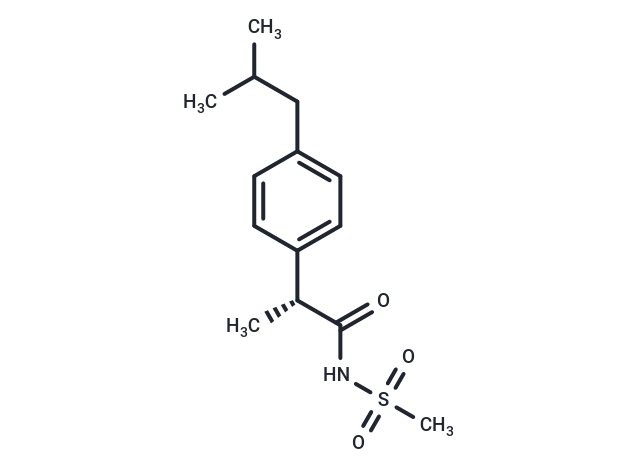Shopping Cart
Remove All Your shopping cart is currently empty
Your shopping cart is currently empty
Reparixin (Repertaxin) is a potent inhibitor of both CXCL8 receptors CXCR1/2, it inhibits weakly CXCR2-mediated cell migration (IC50=100 nM), whereas it strongly blocks CXCR1-mediated chemotaxis (IC50=1 nM).

| Pack Size | Price | USA Warehouse | Global Warehouse | Quantity |
|---|---|---|---|---|
| 5 mg | $40 | In Stock | In Stock | |
| 10 mg | $56 | In Stock | In Stock | |
| 25 mg | $123 | In Stock | In Stock | |
| 50 mg | $197 | In Stock | In Stock | |
| 100 mg | $317 | In Stock | In Stock | |
| 200 mg | $472 | In Stock | In Stock | |
| 1 mL x 10 mM (in DMSO) | $113 | In Stock | In Stock |
| Description | Reparixin (Repertaxin) is a potent inhibitor of both CXCL8 receptors CXCR1/2, it inhibits weakly CXCR2-mediated cell migration (IC50=100 nM), whereas it strongly blocks CXCR1-mediated chemotaxis (IC50=1 nM). |
| Targets&IC50 | CXCR1 (Ile43Val):80 nM (in L1.2 cells), CXCR1:1 nM, CXCR1 (wild-type):5.6 nM (in L1.2 cells), CXCR2:100 nM |
| Cell Research | L1.2 Cell suspension (1.5-3×106 cells/mL) is incubated at 37°C for 15 min in the presence of vehicle or of Reparixin (1 nM-1 μM) and next seeded in triplicates in the upper compartment of the chemotactic chamber. Different agonists are seeded in the lower compartment of the chamber at the following concentrations: 1 nM CXCL8, 0.03 nM fMLP, 10 nM CXCL1, 2.5 nM CCL2, 30 nM C5a. The chemotactic chamber is incubated at 37°C in air with 5% CO2 for 45 min (human PMNs) or 2 h (monocytes). At the end of incubation, the filter is removed, fixed, and stained and five oil immersion fields at high magnification (100×) are counted for each migration well after sample coding. L1.2 migration is evaluated using 5 μM pore size Transwell filters. |
| Animal Research | C57BL/6J mice (8-10 weeks old/20-25 g) are used. The subcutaneous administration of Reparixin (30 mg/kg) is performed 60 minutes before cerebral ischemia induction. The animals are divided into the following three experimental groups: Sham (i.e., the group in which the arteries are visualized, but there is no occlusion of the middle cerebral artery), Vehicle (i.e., the group pre-treated with the vehicle, phosphate buffer solution, 60 minutes before MCAo) and Reparixin (i.e., the group pre-treated with the drug 60 minutes before MCAo). To evaluate neurological signs secondary to MCAo, the animals are assessed with the SHIRPA battery 24 h after reperfusion. |
| Synonyms | Repertaxin, DF 1681Y |
| Molecular Weight | 283.39 |
| Formula | C14H21NO3S |
| Cas No. | 266359-83-5 |
| Smiles | CC(C)Cc1ccc(cc1)[C@@H](C)C(=O)NS(C)(=O)=O |
| Relative Density. | 1.137g/cm3 |
| Storage | Powder: -20°C for 3 years | In solvent: -80°C for 1 year | Shipping with blue ice/Shipping at ambient temperature. | |||||||||||||||||||||||||||||||||||
| Solubility Information | DMSO: 50 mg/mL (176.44 mM), Sonication is recommended. | |||||||||||||||||||||||||||||||||||
| In Vivo Formulation | 10% DMSO+40% PEG300+5% Tween 80+45% Saline: 2 mg/mL (7.06 mM), Sonication is recommended. Please add the solvents sequentially, clarifying the solution as much as possible before adding the next one. Dissolve by heating and/or sonication if necessary. Working solution is recommended to be prepared and used immediately. The formulation provided above is for reference purposes only. In vivo formulations may vary and should be modified based on specific experimental conditions. | |||||||||||||||||||||||||||||||||||
Solution Preparation Table | ||||||||||||||||||||||||||||||||||||
DMSO
| ||||||||||||||||||||||||||||||||||||
| Size | Quantity | Unit Price | Amount | Operation |
|---|

Copyright © 2015-2025 TargetMol Chemicals Inc. All Rights Reserved.